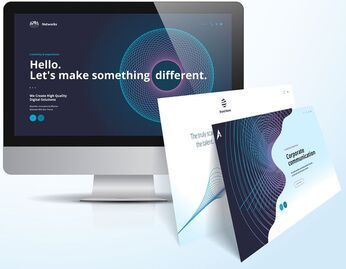
Generating leads from your website design
This month we take a look into how to best design a landing page that generates sales and leads for your business. We dive into a few of the more common principles on conversion generating design, as well as giving a few insights from a 543 Design perspective.
Hick's law
In recent times the great majority of our clients have started to look at not just having a website live and getting people to that website, but how they can get conversions from their website. In this blog we take a look at how you can best set up your landing page and homepage to increase conversions - whether that be through leads or sales.
Sometimes in business, life and design, less can definitely be more. Trusty Wikipedia will tell you that Hick's law (named after William Edmund Hick and Ray Hyman), describes the time it takes for a person to make a decision based on the number of choices they have in front of them. It sounds pretty simple, but the science basically shows that the less choices in front of a person, the quicker they will make a choice. Quick choice's are crucial online. Putting that into practice, if you have a specific goal, you need to make that one choice the only thing the client is pondering. For example... contact us now if you need a website refresh, online advertising, or to put these theories into action on your site!
Rule of thirds
In photography it's widely recognised that if you divide your photo into thirds, it becomes more appealing to the viewer. The same applies to websites, and we can take that a step further. On a PC in particular the user will generally start on the left hand side of the page, then scan down and across it left to right. With that in mind, the 'F' layout is a great one to use - tracing those 'thirds' of the screen. You'll find alot of effective sites will have their call to action placed in the mid/bottom left hand side of the visible portion of the landing page, at the intersection of the bottom left third. Keeping that general layout in mind can really help when setting up your landing pages.
Don't be afraid of blank space
Often when a newbie is putting together a design they think is great, they will shy away from empty spots and white space. They want to cram all their information into the first part of a landing screen, and so think blank space is wasted space. That's a big misunderstanding. Negative space can be used to bring real attention to your call of action, can simplify the page, and can in fact make it look alot better. Use that negative space to draw the user's attention to your call to action button - and remember that simplicity can be the winner on the day.
On this note, definitely give a bit of space between your text by setting a taller line height. At a minimum it's a good idea to have your line spacing at 1.5 times the size of the font - leaving a half gap of white between lines. It is easier for the viewer to read, and also gives a great design aesthetic.
Fitt's law
The placement of your call to action buttons in particular can also be guided by Fitt's law. Borrowing from Wikipedia again, this scientific law predicts that the time required to rapidly move to a target area is a function of the ratio between the distance to the target and the width of the target. So, if your mouse is close to a big button, you will click it more often than a small button that is on the other side of the screen. It's another fairly obvious statement, but critical to getting increased conversions on your homepage. Use a reasonably large button, not too far from the centre of the screen (remembering the 'F' layout) and you should be onto a winner.
Our overall 543 thoughts
Like everything online, there is a balancing act to be had between a highly optimised site for SEO, lead conversion, and a visually good looking website. All of the above can really be narrowed down to the KISS principles of keeping it simple. Focus on one major call to action and one piece of messaging, keep the landing page uncluttered around that call to action button and you're off to a very good start. Ensure the button is big, the colour of it contrasts with the rest of the site, and place it in a sensible place near the centre left of the screen. If you can nail those things on the first load of your landing page, you have a site design targetted at increasing conversions.
This has been a great blog for us to delve into and increasing sales and leads is something we are passionate about. Over the next few weeks we'll expand on this blog and look at other techniques and tools that can help you get the most out of your site. In the meantime, if you have any questions, don't hesitate to contact us.


